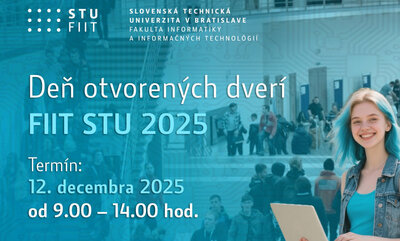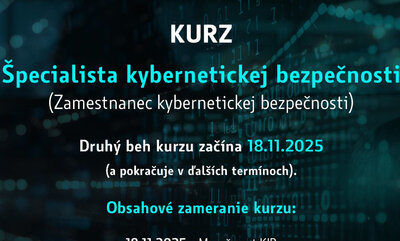Announcement of the defence of the dissertation of Mgr. Pavle Dakić
Dovoľujeme si oznámiť, že dňa 27. augusta 2024 o 9.00 hod.
sa uskutoční na Fakulte informatiky a informačných technológií STU v Bratislave, Ilkovičova 2, 842 16 Bratislava, v miestnosti č. 2.06, obhajoba dizertačnej práce/
We would like to announce that on 27 August 2024 at 9:00 a.m. will be held at the Faculty of Informatics and Information Technology STU in Bratislava, Ilkovičova 2, 842 16 Bratislava, in room No. 2.06, the defence of the doctoral thesis of a PhD student
Mgr. Pavleho Dakića/
Mgr. Pavle Dakić
Názov dizertačnej prác/Thesis title:
Vývoj softvéru v súlade s predpismi v oblasti autonómnych vozidiel/
Compliant Software Development in the Field of Autonomous Vehicles
Odbor/Study field: Informatika/Computer Science
Študijný program/Study program: Aplikovaná informatika/Applied informatics
Školiteľ/Supervisor: prof. Ing. Valentino Vranić, PhD. – FIIT STU v Bratislave
Abstrakt/Annotation:
Dodržiavanie noriem, vlastníctvo prijateľnej stratégie testovania softvéru, fyzické/virtuálne testovanie a opakovane použiteľné testovacie prípady na vytvorenie bezpečného a spoľahlivého softvéru v autonómnych vozidlách. Ak použijeme existujúce riešenia, môžeme zdediť technologický dlh a nevyriešené problémy. V dôsledku toho je potrebný rozsiahlejší výskum na pochopenie logistiky, noriem, rozmanitých požiadaviek a problémov pri vývoji vhodného vývojového prostredia v automobilovom priemysle. V ideálnom prípade, ak chceme byť úspešní pri bezproblémovej reprezentácii a opätovnom použití znalostí o softvéri, musíme najprv zabezpečiť súlad s existujúcimi normami a štandardmi, ktoré sa neustále vyvíjajú. Okrem toho sa zohľadňujú požiadavky používateľov, nedbanlivosť z hľadiska otázok bezpečnosti a zákony krajiny pre pravdepodobné použitie. V dôsledku toho by sa mohli identifikovať potrebné kroky v normalizačných procesoch nariadených svetovými vládami a normalizačnými agentúrami. Koncept, že kódovanie pomocou CI/CD, inteligentné techniky zberu údajov a softvérová inteligencia by mohli urýchliť budúci vývoj, nám umožňuje písať funkcie pokročilejším spôsobom. Bolo by prospešné navrhovať softvér kombináciou viacerých procesov a prístupov k organizácii procesu výroby softvéru, čo by umožnilo vytvárať a získavať nové znalosti. Výsledkom by bolo, že by sa celosvetovo mohla používať jednotná výrobná technika v súlade s normami a špecifikáciami. V tejto práci navrhujeme súbor prístupov riadených dodržiavaním noriem, ktoré sa majú riešiť v automobilových softvérových systémoch, ktoré možno spoločne integrovať zahrnutím týchto prístupov:
- Prístup k architektonickému kontextu je prezentovaný pomocou novej skratky GRCopOps v oblasti CI/CD a možných budúcich aplikácií. Cieľom tohto prístupu je predstaviť zrozumiteľnú formu, ktorú môžu využívať softvéroví architekti v rámci automobilového priemyslu aj mimo neho. Za väčšiny okolností sa proces budovania súladu môže opakovať pre každú fázu vývoja, pretože prístup zachováva jednotlivé procesy. Použitie tohto prístupu umožňuje priame dodržiavanie príslušných noriem a kritérií testovania v rôznych cloudových prostrediach.
- Nový logistický prístup pre trh dodávok pre automobilový priemysel (AutoSupMkt), ktorý rieši výzvy v automobilovom priemysle načrtnutím procesov súvisiacich s dodávkami hotových výrobkov na trh. Špecifikácia tohto procesu definuje potrebné kroky vo výrobnom procese a zabezpečenie potrebných komponentov, ktoré sa dostanú do samotného závodu.
- Prístup, ktorý integruje organizačný proces pre riadenie znalostí (OPKM) a vývoj softvéru načrtnutím spôsobu, akým možno tieto procesy zaviesť. Tento proces zaviedol nový organizačný model a prístup spojením manažérskeho procesu s životným cyklom riadenia znalostí. Táto metóda zahŕňa zreteľné míľniky realizácie, pri ktorých si každý môže vymieňať informácie a získavať nové znalosti na tejto ceste.
- Prístup na integráciu početných algoritmov počas realizácie postupu parkovania vo vozidle (INAP). Základné komponenty tohto prístupu zahŕňajú strojové učenie, kontinuitu edge-to-cloud, internet vecí a rôzne aplikácie parkovania na parkoviskách. Hlavným cieľom vývoja tejto techniky je lepšie pochopiť vývoj softvéru, ktorý spracúva špecifické obrazové informácie a zároveň dodržiava zákonné obmedzenia.
Adherence to standards, ownership of an acceptable software testing strategy, physical/virtual testing, and reusable test cases to produce secure and reliable software in autonomous vehicles. We may inherit technological debt and unresolved difficulties if we use existing solutions. As a result, more extensive research is required to understand the logistics, standards, diverse requirements, and problems of developing a proper development environment in the automobile industry. Ideally, to be successful in the smooth representation and reuse of software knowledge, we must first ensure conformity with existing norms and standards, which are continually being developed. In addition, user requirements, negligence in terms of safety issues, and country laws for probable use are taken into account. As a result, necessary steps could be identified in the standardization processes imposed by world governments and standards agencies. The concept that coding with CI/CD, intelligent data collection techniques, and software intelligence could speed up future development allows us to write functionality in a more advanced manner. It would be beneficial to design software by combining several processes and approaches to organizing the software production process, allowing the creation and acquisition of new knowledge. As a result, a consistent production technique could be used worldwide in compliance with norms and specifications. In this thesis, we suggest a set of approaches driven by standards compliance to be addressed in automotive software systems that can be jointly integrated by including the following approaches:
- An approach to the architectural context is presented using the new acronym GRCopOps within the CI/CD area and possible future applications. The goal of this approach is to present an understandable form that can be used by software architects within the automotive industry and beyond. In most circumstances, the process of building alignment can be repeated for each development phase because the approach preserves individual processes. The use of this approach allows for straightforward compliance with the appropriate standards and testing criteria in different cloud environments.
- A new logistic approach for the automotive supply market (AutoSupMkt) that addresses challenges in the automotive industry by sketching out the processes involved in the supply of finished products to the market. The specification of this process defines the necessary steps in the production process and the provision of the necessary components that arrive at the factory itself.
- An approach that integrates organizational processes for knowledge management (OPKM) and software development by outlining how these processes can be established. This process established a new organizational model and approach by combining the managerial process with the knowledge management life cycle. This method includes distinct milestones of realization at which everyone can exchange information and gain new knowledge along this path.
- An approach for integrating numerous algorithms during the implementation of the parking procedure within the car (INAP). This approach's foundational components include machine learning, edge-to-cloud continuum, IoT, and a variety of parking applications in parking lots. The primary purpose of developing this technique is to better understand the development of software that processes specific video information while adhering to legal constraints.





